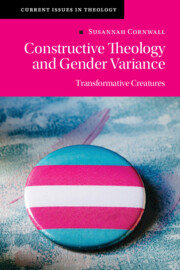Book contents
- Constructive Theology and Gender Variance
- Current Issues in Theology
- Constructive Theology and Gender Variance
- Copyright page
- Dedication
- Contents
- Acknowledgements
- Part I Setting the Scene
- Part II Telling Truths
- 4 Autonomy and Trans People
- 5 Gender Transition, Truth-Telling, and Artifice
- 6 Self-Protection or ‘Gender Fraud’?
- Part III Limits, Technology, and Health
- Part IV Transformative Creatures
- References
- Author Index
- Subject Index
5 - Gender Transition, Truth-Telling, and Artifice
from Part II - Telling Truths
Published online by Cambridge University Press: 14 December 2022
- Constructive Theology and Gender Variance
- Current Issues in Theology
- Constructive Theology and Gender Variance
- Copyright page
- Dedication
- Contents
- Acknowledgements
- Part I Setting the Scene
- Part II Telling Truths
- 4 Autonomy and Trans People
- 5 Gender Transition, Truth-Telling, and Artifice
- 6 Self-Protection or ‘Gender Fraud’?
- Part III Limits, Technology, and Health
- Part IV Transformative Creatures
- References
- Author Index
- Subject Index
Summary
In Chapter 7 I will turn more explicitly to the doctrine of creation, but here we begin that journey through the lens of theological anthropology. We will consider, in particular, how far our bodies communicate truths about us, and, concomitantly, what our attachment to gender as well as to sex tells us about ourselves as humans. I suggest, for example, that our frequent theological appeals to truth, and particularly our desire that our bodies communicate what we perceive to be truths about us accurately, point to a concern and regard for our animality. Our desire that our bodies communicate honestly also gives a hint that as humans we tend to embrace order and give a high place to social and psychological systems that allow us to manage our expectations and minimize danger. This latter tendency has a more sinister flip side: the concomitant fact that we often create and cling to arbitrary and over-solidified delimitations to exercise power, and that therefore no appeal to monolithic repositories of truth is likely to be innocent, especially where it means policing others’ self-projections.
- Type
- Chapter
- Information
- Constructive Theology and Gender VarianceTransformative Creatures, pp. 139 - 161Publisher: Cambridge University PressPrint publication year: 2022



